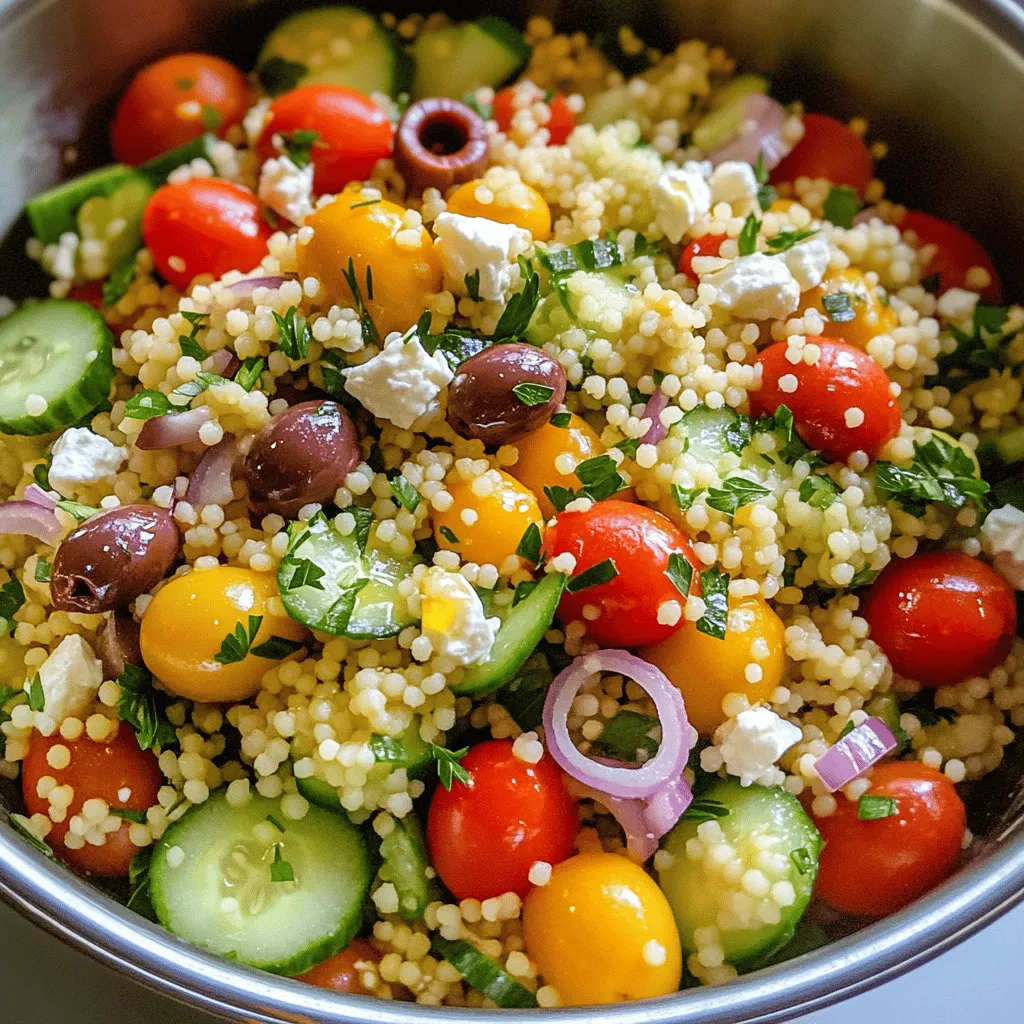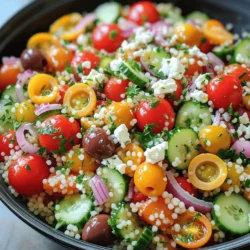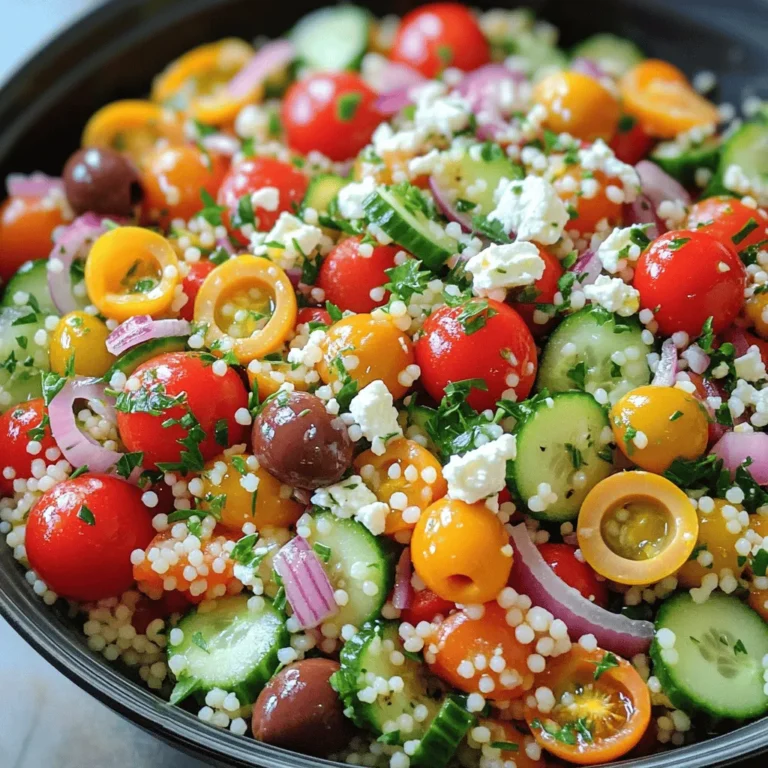Looking for a meal that’s both tasty and easy to make? This Mediterranean Couscous Salad is just what you need! Packed with vibrant veggies and rich flavors, it’s a perfect side or light main dish. With simple steps and fresh ingredients, you can whip this up in no time. Let’s dive into this delicious recipe and learn how you can enjoy a healthy meal that everyone will love!
Ingredients
Key ingredients for Mediterranean Couscous Salad
To make a delicious Mediterranean couscous salad, gather these key ingredients:
– 1 cup couscous
– 1 1/4 cups vegetable broth
– 1/2 cup cherry tomatoes, halved
– 1/2 cucumber, diced
– 1/4 red onion, finely chopped
– 1/2 cup Kalamata olives, pitted and sliced
– 1/2 cup feta cheese, crumbled
– 1/4 cup fresh parsley, chopped
– 1/4 cup olive oil
– 2 tablespoons lemon juice
– 1 teaspoon dried oregano
– Salt and pepper to taste
These ingredients bring bright colors and fresh flavors to the dish.
Nutritional Breakdown of Ingredients
This salad is not just tasty; it’s healthy too. Here’s a quick look at the nutrition:
– Couscous: A good source of carbs. It gives energy.
– Vegetable broth: Low in calories. It adds depth of flavor.
– Vegetables: Tomatoes, cucumber, and onion add vitamins and minerals.
– Kalamata olives: They offer healthy fats. They also bring a nice briny taste.
– Feta cheese: Adds protein and calcium. It gives a creamy texture.
– Olive oil: A heart-healthy fat that enhances flavor.
– Lemon juice: Adds brightness and vitamin C.
– Oregano: A herb that supports digestion.
Alternative Ingredients for Substitutions
If you need to make changes, here are some great swaps:
– Couscous: Try quinoa or farro for a gluten-free option.
– Vegetable broth: Use chicken broth for a richer flavor.
– Feta cheese: Crumbled goat cheese works well too.
– Olives: Green olives can replace Kalamata olives.
– Herbs: Fresh basil or mint can add a different twist.
These swaps allow you to customize the salad to fit your taste or dietary needs.
Step-by-Step Instructions
Preparation steps for the couscous
First, heat 1 1/4 cups of vegetable broth in a medium saucepan. Bring it to a boil. Once boiling, add 1 cup of couscous and stir quickly. Cover the pot and remove it from heat. Let it sit for about 5 minutes. The couscous will absorb the broth. After that, fluff it with a fork and let it cool for a few minutes.
Combining vegetables and dressing
While the couscous cools, grab a large mixing bowl. Add 1/2 cup of halved cherry tomatoes, 1/2 diced cucumber, 1/4 finely chopped red onion, and 1/2 cup of sliced Kalamata olives. Then, add 1/2 cup of crumbled feta cheese and 1/4 cup of chopped fresh parsley. In a small bowl, whisk together 1/4 cup of olive oil, 2 tablespoons of lemon juice, 1 teaspoon of dried oregano, salt, and pepper. This is your dressing.
Final assembly and serving suggestions
Once the couscous cools slightly, add it to the mixing bowl with the veggies. Pour the dressing over everything. Gently toss to mix, making sure all ingredients are coated. Taste the salad and adjust seasoning if needed. Let it sit for at least 15 minutes. This helps the flavors blend.
For serving, place the salad in a large bowl or on individual plates. Garnish with extra parsley and a sprinkle of feta on top. Drizzle a bit more olive oil right before serving for added shine.
Tips & Tricks
Common mistakes to avoid
When making Mediterranean couscous salad, watch out for a few common errors. First, do not overcook the couscous. It should be fluffy, not mushy. Second, skip the bland dressings. Always use fresh lemon juice and quality olive oil for a bright flavor. Lastly, avoid skipping the resting time. Letting the salad sit allows the flavors to blend.
How to enhance flavors
To boost the taste of your salad, consider adding fresh herbs like mint or basil. These herbs bring a nice twist. You can also try adding crushed red pepper for some heat. For a citrus kick, add more lemon juice or zest. A splash of balsamic vinegar can deepen the flavor profile too.
Best practices for serving
When serving, presentation matters. Use a large bowl for family-style serving or individual plates for a fancy touch. Sprinkle extra feta and parsley on top for color. Drizzle some olive oil right before serving for a shiny finish. This makes your dish look as good as it tastes.

Variations
Seasonal ingredient options
You can change the flavors of your Mediterranean couscous salad with seasonal ingredients. In spring, add fresh asparagus or peas for a pop of green. In summer, toss in some sweet bell peppers or zucchini. Fall and winter bring hearty options like roasted butternut squash or kale. Using fresh, seasonal produce makes your salad vibrant and tasty.
Protein-rich additions
To make your salad more filling, add protein. Chickpeas are a great choice. They blend well with the other flavors. Grilled chicken or shrimp also works nicely if you enjoy meat. For a different twist, consider adding diced hard-boiled eggs. These options not only add protein but also enhance the overall taste of the salad.
Vegan or gluten-free adaptations
You can easily adapt this salad to fit dietary needs. For a vegan version, simply leave out the feta cheese. Replace it with avocado or a sprinkle of nutritional yeast for a cheesy flavor. If you need a gluten-free option, substitute couscous with quinoa or rice. These swaps keep the meal delicious and satisfying while meeting your needs.
Storage Info
How to store leftovers
To keep your Mediterranean Couscous Salad fresh, store it in the fridge. Place the salad in an airtight container. This helps keep it from drying out. Try to eat it within three days. The flavors will still be good, but the veggies may lose some crunch.
Best containers for storage
Use glass containers with tight lids for the best results. They keep the salad fresh and let you see the colorful layers inside. If you have plastic containers, make sure they are BPA-free and seal well. This keeps your salad safe and tasty.
Reheating instructions
Reheating couscous salad is simple but not always necessary. If you prefer it warm, microwave it for about 30 seconds. Stir it halfway to heat evenly. You can also serve it cold, which many people enjoy.
FAQs
How do I make my couscous salad more flavorful?
To boost flavor in your couscous salad, try these tips:
– Use broth instead of water when cooking couscous. It adds depth.
– Add herbs like mint or basil for fresh notes.
– Mix in spices such as cumin or paprika for warmth.
– Include citrus zest to brighten flavors. Lemon or lime work well.
– Toast the couscous briefly in olive oil before adding broth. This adds a nutty taste.
These small changes can make a big difference in taste.
Can I make this salad ahead of time?
Yes, you can make this salad ahead of time. It actually tastes better after sitting. The flavors meld together nicely. I suggest preparing it a few hours in advance. Just keep it in the fridge until you’re ready to serve. If you want to make it even earlier, you can store the couscous separately from the vegetables and dressing. This keeps everything fresh and crunchy.
What can I serve with Mediterranean Couscous Salad?
You can serve this salad with many dishes. Here are some great options:
– Grilled chicken adds protein and pairs well.
– Fish, like salmon or tilapia, complements the salad’s flavors.
– Pita bread or hummus makes for a fun side.
– Roasted vegetables add warmth and texture.
– A light soup, like tomato or lentil, can round out the meal.
These pairings create a satisfying and balanced meal.
This blog post covered the essential parts of making Mediterranean Couscous Salad. We explored key ingredients, nutritional facts, and ways to switch things up. You learned step-by-step how to prepare and serve the dish. I shared tips to avoid common mistakes and enhance flavors. Plus, we looked at different variations and storage tips for leftovers.
In conclusion, this salad is versatile and easy to customize. Enjoy making it your own!


